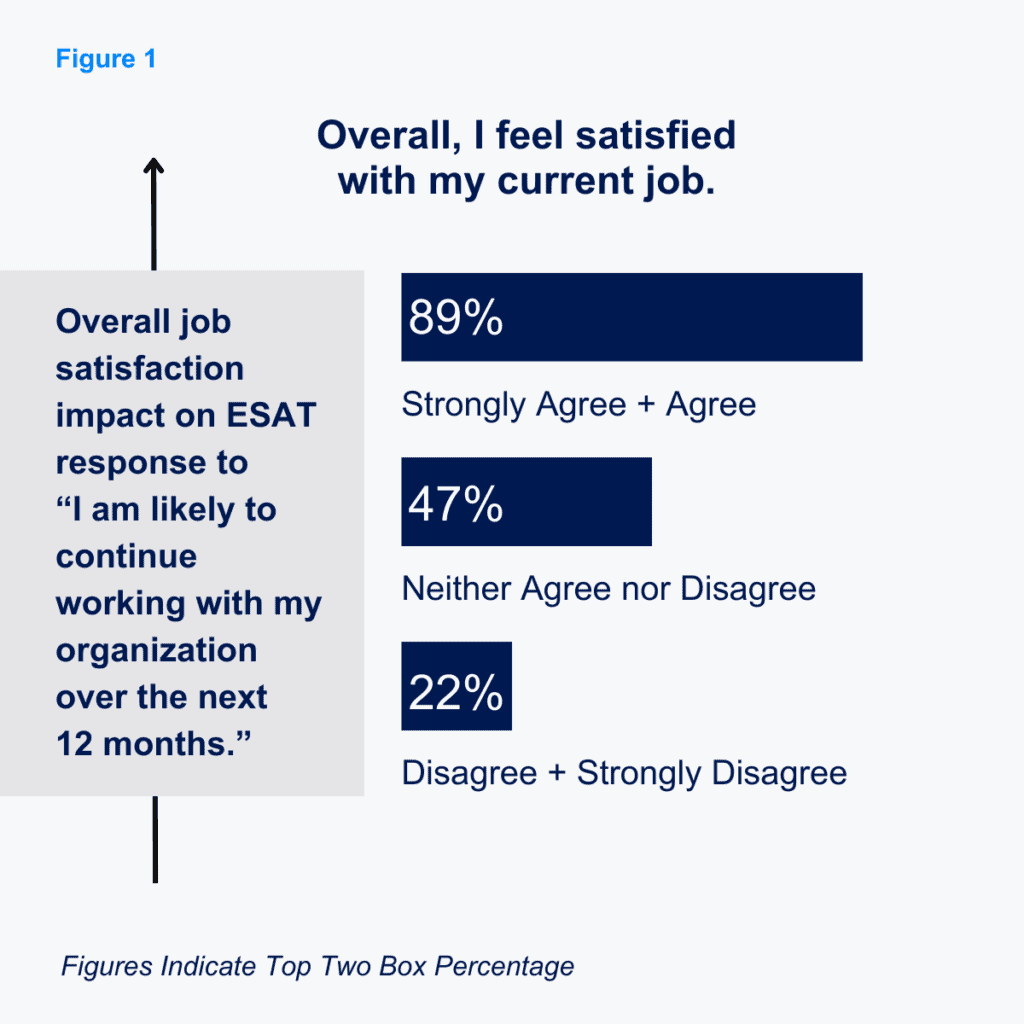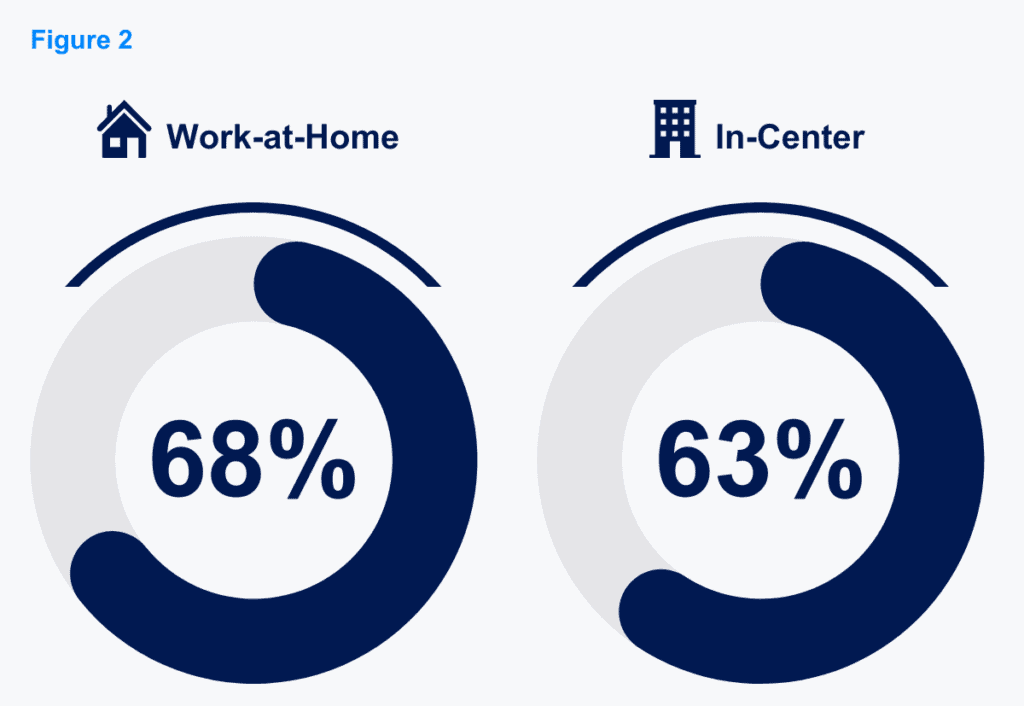
March 11, 2024
Early attrition poses a significant and costly challenge for contact centers. To address this issue, COPC Inc. and Centrical have teamed up to present the Improving Contact Center Retention Series, offering strategies to increase call center retention and lower attrition-related expenses.
The essence of effective leadership is the ability to ask discerning questions and act to cultivate an environment of growth and satisfaction. This guide sheds light on the multifaceted nature of employee retention, aiming to enhance customer satisfaction and other key performance indicators through careful questioning and thoughtful leadership actions.
Below, we present the culmination of our insights with critical questions that leaders need to consider throughout the employee lifecycle. Its purpose is to guarantee newcomers envision a lasting career with your organization instead of viewing their position as short-term employment.
The Proof is in the Data

Figure 1 provides a definitive snapshot of how job satisfaction influences employees’ intentions to stay with their current employers. Notably, individuals with a job satisfaction rate of 89% are inclined to remain, whereas those expressing dissatisfaction, marked at 22%, are more prone to seek employment elsewhere.
Hiring Questions Leaders Should Ask
The foundation of employee retention is precisely defining the role and giving an accurate job description. Then, take steps to attract and recruit the best-fit candidates who meet minimum hiring requirements. Ask the following questions for a more robust hiring process:
- Have we set clear minimum criteria for hiring and training to ensure we onboard the ideal team members?
- Did we mistake any “experience proxies” for actual skills?
(Having sales experience does not mean one excels at sales.) - Did we analyze top performers in our organization to arrive at data-driven requirements instead of relying on logical guesses?
See here for more information about how to do this.
- Did we mistake any “experience proxies” for actual skills?
- Does the job description and posting align with pertinent minimum hiring requirements and expectations around the role?
- Should this role be fully in-office, hybrid, or remote?
- Have we considered current research showing that at-home employees are more satisfied than those required to go into an office? See Figure 2.
- Have we explored the tools available to create a performance-driven culture for at-home employees as we do with their in-office counterparts?

Preboarding Questions Leaders Should Ask
Preboarding emerges as a pivotal phase in the retention process. A lack of engagement can lead new hires to reconsider their decision before starting.
Use the following questions to evaluate your preboarding process and improve the overall experience for new employees. This action guarantees that your newest team members remain enthusiastic and committed from acceptance to their first day.
- How do new hires perceive their journey from the moment they accept our offer to their first day at work?
- What are the types and frequency of communications during this period?
- Do the new hire’s expectations align with the realities of the role?
- What quantitative and qualitative evidence supports our understanding of this alignment?
- Are we successfully engaging new hires and keeping them excited about joining our team?
- If we are, how can we enhance and build upon this process?
- If we are not, what strategies and timelines are we considering for implementing this best practice?
Consider a solution such as Centrical onboarding to provide the tools and built-in processes to engage new employees.

Related
Call Center Attrition: Avoid the Dilemma of First-Day Ghosting provides an actionable overview of creating an accurate job description and implementing a successful preboarding program to prevent attrition before day one.
The First 90 Days Questions Leaders Should Ask
With alarmingly high 90-day attrition rates, it is essential to support new hires closely during this time. By guiding them through a personalized experience, you can better engage them and set them up for success. Ask the following questions to establish a strong base for long-term retention.
Training
- What is our first-day attendance rate for new hires? (This is a recruitment quality metric.)
- Do new hires find training effective, equipping them with the knowledge and skills to excel beyond the hiring phase?
- Do our learners find the training experience engaging or boring? How do we know?
- Have we analyzed the post-training attrition rates to identify if they’re too high (indicating a potential issue with passing everyone through) or too low (suggesting a possible recruitment quality concern)?
- Are we providing insights into attrition rates and qualitative and quantitative feedback on recruitment quality and class pass rates?
- Is the loop-back process efficient and effective?
Performance Culture
- Are new hires aware of how their role aligns with the overall strategy?
- Are new hires aligned with the role and its expectations? Are we getting feedback in this area to inform recruiting and training?
- Is the loop-back process efficient and effective?
- What are we doing from a performance culture perspective if new hires are not aligned with their role and expectations?
- Do new hires feel confident in managing their workload and responsibilities?
- If not, what support is available to them?
- What does the coaching process look like?
- Do managers have the bandwidth and tools/processes to prepare for coaching conversations and give meaningful feedback?
- Are we reinforcing new hire training on the floor and identifying gaps in training design?
- Have we evaluated the efficiency and scalability of the loop-back process and training material development?
Overall Employee Engagement
- Are we creating a welcoming environment for new hires?
- Do new hires understand the company’s mission, vision, and values?
- How can I make sure this is true?
- Do new hires feel their work contributes meaningfully to the company’s success?
- Do new hires feel they will have a clear career path within the organization?
- Are we investing in ongoing (post-new hire training) skills and knowledge development?
- Do employees feel that leaders’ communication about the ongoing business needs and strategies for success is effective and transparent?

Related
Onboarding Best Practices: Reducing Attrition in the First 90 Days focuses on why new hires leave during the first 90 days and tips to increase the likelihood of a new hire becoming a long-time employee.
New Hire Focus Groups
The most successful leaders have direct conversations with employees, particularly those in their initial 90 days, even though it may be difficult to maintain regularly. It’s important to ask open-ended and follow-up questions to gain deeper insights:
- Does the job meet your initial expectations? Please explain.
- What are the most significant challenges you encounter in your role?
- Do you have suggestions on how we can engage and motivate you more?
- Are there specific actions the company, including my role as a leader, could implement to enhance your experience as an employee?
- How do you describe the workplace and your role to others?
- Is your employment here a source of pride or a temporary step until you find a better fit?
Considerations for Technology Solutions to Drive Employee Retention
Technology can be a powerful solution to refine the new hire experience while inspiring and sustaining employee performance. As you consider adopting a platform, focus on the following to ensure the technology can increase employee retention:
- Real-time Performance Insights: Does the platform offer instant visibility into KPIs and behaviors, enabling managers and agents to track progress and identify areas needing additional support?
- Coaching Features: Are there AI-driven insights for managers that significantly reduce administrative tasks, allowing for focused coaching and automated action plans?
- Microlearning Integration: Does the solution incorporate microlearning to combat the forgetting curve, enhancing new hires’ skills through short, impactful learning sessions during their workflow?
- Personalization of Microlearning: If included, is there AI-powered customization that delivers content based on specific knowledge gaps and performance levels?
- Culture of Learning: Does the platform promote continuous learning through features like social knowledge exchange and individualized learning paths?
- Training Material Development: Does the solution use generative AI to create training materials that ensure a quick, effective, and scalable method for frontline resource development?
- Gamification: Is the platform equipped with advanced gamification features to enhance motivation, engagement, and performance from preboarding through to onboarding? Does the platform go beyond basic gamification to include elements like level progression, immersive narratives, and segmented leaderboards to reward and recognize employees?
- Employee-Centric Approach: Does the solution support a “Voice of the Employee” feature, facilitating feedback collection to understand employee satisfaction with the workload, work-life balance, and overall well-being, thereby aiding in the continuous program improvement?
Conclusion
Early attrition is a challenge and an opportunity for contact centers to rethink and refine their approach to employee retention. As leaders, adopting an employee-centric approach and ensuring open lines of communication can transform the early stages of employment into a foundation for lasting engagement and success.
Effective leadership involves asking insightful questions that drive internal reflection and improvement. We have offered ways to navigate success through strategic inquiry and action to improve retention rates, customer satisfaction, and key performance metrics.
The main takeaways emphasize the significance of a well-defined job role, an engaging preboarding and onboarding process, and a supportive performance-driven culture that aligns with employees’ expectations and the company’s strategic goals.
Moreover, integrating technology solutions plays a pivotal role in improving the new hire experience, underscoring the necessity for platforms that offer real-time insights, personalized learning, and a culture of continuous improvement.
Ultimately, the journey to reducing attrition and enhancing employee satisfaction is ongoing, requiring a commitment to understanding the needs and experiences of new hires. By implementing these insights, contact centers can improve retention and build a more motivated, engaged, and high-performing workforce.
Insights in Action
Through the Improving Contact Center Retention Series, we’ve been investigating effective methods for organizations to minimize early turnover, offering solutions to tackle this pervasive problem, thereby reducing associated costs.

We asked Camila Ferreira, Senior Director of Client Experience at SpotOn, for her insights following a remarkable surge in employee and customer satisfaction within their support organization over the last 14 months. Here’s how she responded to our inquiry about her initial priorities during the SpotOn CX transformation.
Question: What was your strategy for success as you walked in the door? What were your first priorities?
Answer: It all began by establishing a clear team vision: “Become the client experience industry leader by executing top-notch, efficient processes with a humanized approach.” Working backward from this vision, I initiated a comprehensive overhaul of the organization, addressing critical aspects by:
- Defining roles and responsibilities using COPC’s Minimum Requirements Template
- Aligning job descriptions with roles and responsibilities
- Establishing a span of control designed for SpotOn’s growth stage
- Streamlining our incentive program to align with business needs, including consistent metrics across various organizational levels
- Ensuring employees who needed management training to learn best practices had access, such as sending our quality leader to COPC Best Practices for Quality Management training or hiring resources who already attended COPC Best Practices in Customer Experience Operations, including my role
- Introducing a new compensation guideline
- Fostering a management-by-performance culture
COPC helps organizations attract and maintain a highly engaged workforce, resulting in less time and money spent on recruitment and training due to lower staff attrition. Learn more about how COPC Inc. Employee Engagement Services can help your organization pinpoint the main factors contributing to employee satisfaction and retention.
For over a decade, Centrical has helped the world’s leading contact centers keep employees engaged and retained from preboarding through production. Learn more about Centrical and how our employee performance experience platform can drive impact at your organization by watching the platform in action with a sneak preview and booking your personalized overview today.

